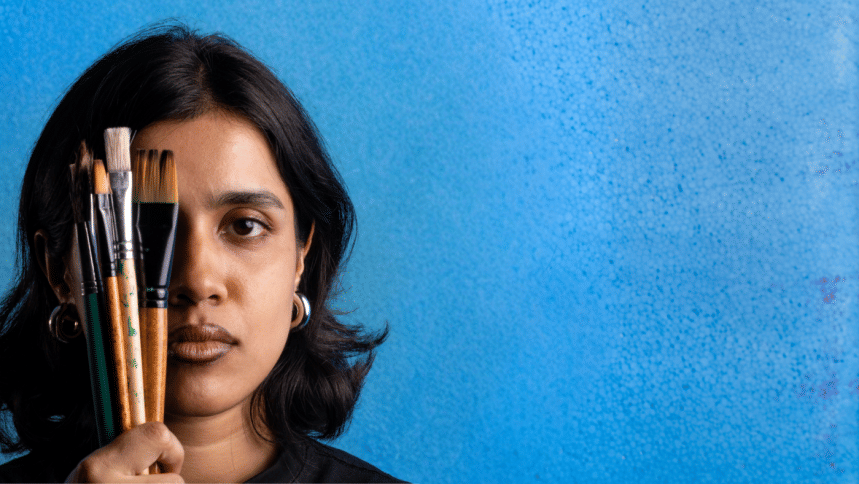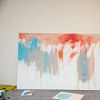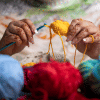The crises facing young artists in Bangladesh

Bangladeshi people have always been known for their resilience, but we are also known for our culture, art, and literature. Since before the independence of Bangladesh, and even after its liberation, our people have always expressed themselves with pen and paper, paint on canvases, and with strings of words often expressed in rhythm.
It is, therefore, essential to understand that when we talk about revolutions, the only medium to commemorate such events is through art and literature. However, when it comes to giving due diligence to the words on the placards or the paint on the walls, we somehow forget to remember our artists and writers – the creators, and chanters on the streets, stirring up a movement, serving as the face of the uprising of the people. If we take into consideration how many artists have gone without credit all these years, we will also realise that not much has changed in recent times either.
Amit Das*, 32, a visual artist based in Dhaka, notes how Bangladeshi artists not only struggle in terms of receiving recognition. He highlights how artists are not necessarily always allowed to be blatantly expressive, given how, at times, they are faced with censorship, which, in that way, takes away from their creative freedom. He recounts, "As artists in Bangladesh, we often face challenges like limited funding, lack of institutional support, and restricted access to international platforms. There are also struggles with censorship, social conservatism, and the pressure to conform to commercial trends rather than creative freedom."
According to Amit, commercialisation can serve as a limitation for the arts, as mass media play a powerful role in shaping public taste by promoting certain trends, styles, and narratives that are easily marketable. However, there are positive sides to commercialisation as well, as he says, "While this can sometimes limit diversity in artistic expression, it also has the potential to popularise art and bring it to a wider audience when used thoughtfully. At least in recent times, many young artists lack access to quality training, mentorship, and exposure to global art practices. Strengthening art education, creating more public art spaces, and offering structured platforms for emerging talents would empower sustainable growth. Financial support is also important, but it becomes far more effective when backed by strong institutions and informed guidance."

Abdullah Al Mukramin, 22, an online-based artist, popularly known as Kawaiikhoka on social media, agrees with Amit's sentiments, as he notes how commercialisation has rather helped him in advancing as an aspiring artist. He notes, "In my case, it worked out in my favour. As the concepts I work with are mostly based on folklore characters, such as Thakuma'r Jhuli, or the children's show, Sisimpur, which are well known in the mass media, but this might not be the same for everyone. So, I definitely do think the art and culture scene is in crisis. Although art is a very integral part of our traditions, with the changing times, along with the mass use of AI, art has come to a critical stage."
Another issue artists come across is copyright and intellectual property theft. Abdullah further adds, "The main challenge I face is most likely people trying to steal intellectual property. As a small artist, the new ideas often get copied or passed off as inspired work without any proper crediting. For people who see the copied work first, they mistake it as the original work."
Like visual artists, writers too are facing setbacks in expressing their work, often being unpaid by publishers, or at times facing censorship in their craft. Shamsuddin Khan Rajit, 23, an aspiring writer who recently published his book, Tears of a Menace, highlights the difficulties he encountered during his journey as a budding author.
For Shamsuddin, it is not only the hindrances that the society imposes on artists that trouble him, but he also highlights how, at times, the difficulties begin at home. "We live in a capitalist society, where surviving and earning are more valued and respected than artistic expression and culture. Even at home, we are raised in a survivalist mindset, where children are often brought up with no sense of individuality or artistic expression. Hence, art or cultural activities are frowned upon in Bangladesh as it is seen only as a means of amusement, nothing more."
Shamsuddin further notes how, while there are more opportunities now for writers to get more exposure by participating in the many cultural activities, there is still a lack of support, given how art, at times, may seem elitist, belonging to a certain group of people. "I believe there is a certain disparity in the connectivity of such communities. These communities that hold such festivals and events attract a niche crowd that they cater to and market to. This can change if these festivals and events can successfully attract and include artists from all walks of life, by taking initiatives to discover them and including them to build a stronger community that will also attract consumers from all walks of life. There is a certain remoteness when it comes to accessibility to such festivals or events."
He also emphasises how it is ultimately how economic privilege may determine creative expression. Shamsuddin says, "As far as I can tell, if you have money to publish and carry out everything on your own, I would say you are unlikely to face any barriers to entry. The deep-rooted corruption that has been so evident for so long has prevented a number of books from being published that may, as it would encourage the reader to think for themselves. These restrictions have raised a generation of people who are afraid to question, think, and take charge."

Shakila Khan, 53, a senior artist and writer, however, argues that Bangladeshi artists have never been afraid to express themselves, and it is through the hands of such brave artists that our culture has been uplifted globally. She says, "The world is recognising and appreciating our art and culture. I believe that as our country continues to develop economically, we will receive even greater recognition here at home. Because, no matter the state of the country, in terms of quality, our art is already at a high level."
Shakila recounts her fair share of struggles as an artist, while noting how it has become more difficult for the new generation of artists. She states, "For visual artists nowadays, the scope of work has shrunk. During my time, at least we got to nurture our interests and learned everything hands-on. We received help from our teachers. If we didn't understand something, they would patiently teach us over and over again. In contrast, this generation relies more on devices. Yet it's also true that with more access to information, they are better able to keep pace with the world."
Shakila further adds, "Even institutionally, the arts have fallen behind. Schools no longer have dedicated Fine Arts departments. The art market has stalled. Financially, artists are not doing well. Art camps aren't happening. Some galleries have closed down. Even those who run art businesses are falling behind. Freedom of expression has become a relative concept now."
It has become essential to understand that despite all the challenges we as a country collectively face, we must not forget those who elevate and preserve our culture and our language. In the time of crisis, it is our artists and writers who give us a voice when words fail, and they stand as an emblem of our red and green flag. It has become crucial that we honour the legacy of those who came before, and even more paramount that we nurture the new generation of artists.
*Names have been changed upon request for privacy
Afra is a finicky student of English Literature at North South University. Send her your thoughts at [email protected]

 For all latest news, follow The Daily Star's Google News channel.
For all latest news, follow The Daily Star's Google News channel. 









Comments